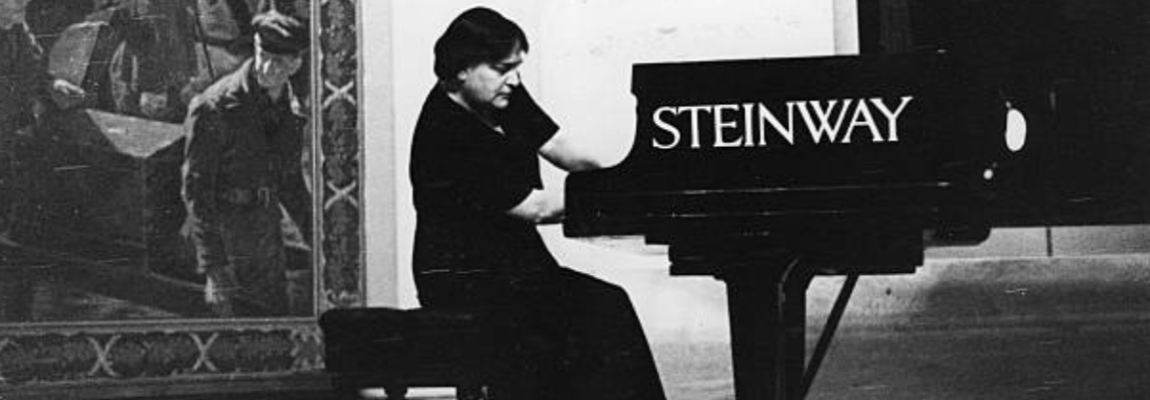Our perceptions of many artists are formed by the recordings we’ve heard, biographical details that have been 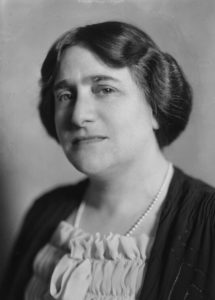 publicized, and photographs that we’ve seen – and as always, while these can give us a snapshot of who someone was, these are always but a fraction of who they truly were. When it comes to the great British pianist Dame Myra Hess, two points are among the most shared: her wartime concert series at the National Gallery in London and her arrangement of Bach’s beloved chorale prelude Jesu, Joy of Man’s Desiring. Her thoroughly brilliant idea to create daytime concerts at the National Gallery did a great deal to raise the spirits of the general public in war-torn England, endearing her to people of every demographic. One oft-repeated tale illustrates how wide a public she reached: a man sharing a train with a soldier whistling the Jesu, Joy chorale asked if he enjoyed Bach’s music, to which the soldier replied, “That’s not Bach, that’s Myra Hess.”
publicized, and photographs that we’ve seen – and as always, while these can give us a snapshot of who someone was, these are always but a fraction of who they truly were. When it comes to the great British pianist Dame Myra Hess, two points are among the most shared: her wartime concert series at the National Gallery in London and her arrangement of Bach’s beloved chorale prelude Jesu, Joy of Man’s Desiring. Her thoroughly brilliant idea to create daytime concerts at the National Gallery did a great deal to raise the spirits of the general public in war-torn England, endearing her to people of every demographic. One oft-repeated tale illustrates how wide a public she reached: a man sharing a train with a soldier whistling the Jesu, Joy chorale asked if he enjoyed Bach’s music, to which the soldier replied, “That’s not Bach, that’s Myra Hess.”
Early years
Julia Myra Hess was born into an Orthodox Jewish family in the Hampstead area of London on February 25, 1890. The youngest of four children, she first piano lessons took place at the age of five and she went on to enter the Guildhall School of Music and in the autumn of 1903 won a scholarship to the Royal Academy of Music, where she would study under the legendary British pedagogue Tobias Matthay. She had two lessons a week with ‘Uncle Tobs,’ who also taught her childhood friend Irene Scharrer (who was not, as has been reported Hess’s cousin).
Her official debut (which she funded herself) took place on November 14, 1907 at Queen’s Hall: she played Beethoven’s Piano Concerto No.4 and Saint-Saëns’s Piano Concerto No.4 with conductor Thomas Beecham (then aged only 29), in addition to a group of solos. Beecham was still not well known, and Matthay wrote to Myra, “Who is this fellow Beecham? If he doesn’t accompany properly, I shall come and do it myself.” The performance was well received and her solo debut followed soon after, a January 1908 recital at Aeolian Hall, where an audience of 312 was serenaded by her performances of Schubert’s Wanderer Fantasie, Franck’s Prelude, Chorale, and Fugue, the Bach-D’Albert Organ Prelude and Fugue in D Major, and pieces by Brahms, Chopin, and Matthay.
American success
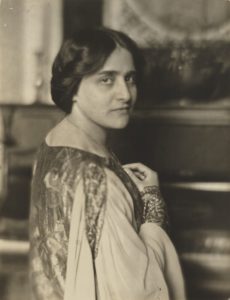
Hess would build her career and become a major international artist, going to America virtually every year from 1922 with the exception of the war years. Her first performance took place in New York five days before her Aeolian Hall recital of January 17, 1922, a preview ‘intimate recital’ was to introduce her to local managers and concert society directors. Alas, only 66 people showed up for the actual debut (the capacity was 1200), which was apparently normal for newcomers, but the reviews were wonderful, the Tribune review stating that
She is every inch an artist; every fibre in her comely and well poised body is musical. Her knowledge, instincts, technical skill are of the highest order. She possesses not only fancy but the higher gift which is imagination. Her expositions are not merely intellectual, they are poetical also. The book of music is open to her.
Hess would become a local favourite in a short period of time, touring widely in both recital and concerto appearances. During her 1937 tour to the US, she gave a broadcast on March 7 on the Ford Sunday Evening Hour in which she played the first movement of the Grieg Piano Concerto, two Chopin Etudes, and a Bach Gigue. When in discussions to finalize the terms of the broadcast, the pianist was offered the sum of $3000. She was stunned that the fee should be so high, and said “Why, that’s ridiculous!” Misinterpreting the tone of her surprise, the agent responded, “All right, then. Make it $4000!”
After a challenging rehearsal, the broadcast itself almost turned into a disaster. Hess had booked an elegant hotel room thanks to her high fee, but the door to her suite got jammed. She eventually got out and made it to the hall on time, and was seated on a chair on the stage while the first work on the programme was played. As she started to walk across the stage for her appearance, the tympani roll of the opening of the Grieg Concerto started – evidently conductor Victor Kolar had not waited for her to get to the piano – and she is said to have made ‘a running dive for the keyboard,’ managing to get there just in time to play the opening chords. All things considered, it’s remarkable how well she played! Most of the works in this broadcast are not in her commercial discography: while she had recorded the Schumann Concerto (twice), she never set down the Grieg with which it is so often paired, and there are no Chopin Etudes amongst her studio recordings either.
The National Gallery Concerts
Hess is particularly remembered today for having created a series of concerts Wartime concerts at the National Gallery in London “to give spiritual solace to those who are giving all to combat the evil.” The first concert was 10 October 1939, a piano recital by Hess herself (“in case the whole thing is a flop”) and over the following six and a half years (they continued after the war while the country continued to heal), there were 1,968 concerts seen by 824,152 people; Hess personally played in 150. Each artist, regardless of status, was paid 5 guineas.
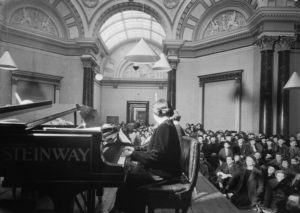
Hess put her listeners at ease and the experience did the same for her – so much so that she allowed herself to break from convention by using scores rather than playing from memory. While she usually had a photographic memory – to the degree that she would actually see the notes on the printed page in her mind – under times of stress, this was naturally compromised: “We’ve trained the public to think we’re infallible when there are… days when some of us can’t remember our own telephone numbers.” She additionally created a more informal atmosphere by speaking directly to the audience between works: she would ask if they were comfortable, invite them to have a good cough before she began the next work, or even acknowledge that she’d lost a sheet of music before stopping playing to search for it on the floor.
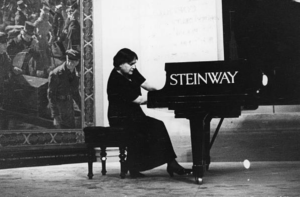
Hess played with remarkable calm even in the most arduous circumstances. At her July 21, 1943 recital she was playing the Schubert Impromptu in B-Flat Major D.935 when she heard a bomb approaching. “I made a tremendous crescendo to cover the noise of the bomb as it flew over the gallery, and as it passed over, an equally unauthentic diminuendo. The amusing thing was that the crescendo synchronized so completely with the horrible noise overhead that no one was conscious of what I had done” – though she added that if anyone had walked in in the middle, they’d have thought she was playing the Brahms B-Flat Concerto!
This video excerpt captures some of Hess’s playing during a National Gallery performance of a Mozart Concerto, plus an excerpt of the first movement of Beethoven’s Appassionata Sonata.
A kind soul has finally published on YouTube the film footage of Hess playing the complete first movement of the Appassionata – absolutely superb in every respect. One can only hope that some day the entire film will be found and made available!
Postwar Accolades
Hess had been made a Dame Commander of the Order of the British Empire by King George VI in 1941 (she had been made CBE in 1936). After the war, she was given an honourary degree at the University of Manchester for her having ensured that ‘among this people, the sound of music should never be silenced by the din of war,’ and she was further celebrated at a gala evening held at the Savoy Hotel in London on June 14. She then resumed touring both Europe and North America to continued acclaim.
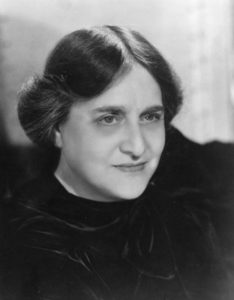 On her return to New York, she gave a November 24, 1946 concert of Beethoven’s Piano Concerto No.3 with Arturo Toscanini conducting the NBC Symphony Orchestra. Hess had originally been engaged to play the Emperor but found the conductor’s tempi at the first rehearsal two days before the concert were so quick that she discreetly suggested that they play the C Minor instead (“everyone plays the Emperor…,” she told him). Despite the program having already been announced (and it being so soon before the performance!), he agreed – and while his tempi are brisk in this account too, it was much more manageable for the soloist.
On her return to New York, she gave a November 24, 1946 concert of Beethoven’s Piano Concerto No.3 with Arturo Toscanini conducting the NBC Symphony Orchestra. Hess had originally been engaged to play the Emperor but found the conductor’s tempi at the first rehearsal two days before the concert were so quick that she discreetly suggested that they play the C Minor instead (“everyone plays the Emperor…,” she told him). Despite the program having already been announced (and it being so soon before the performance!), he agreed – and while his tempi are brisk in this account too, it was much more manageable for the soloist.
At the second rehearsal, Toscanini – conducting from memory – brought the orchestra in four measures too early during the piano’s solo introduction in the slow movement. Hess wasn’t sure how to broach the subject with the fiery maestro but was her usual charming self. The melody played by the piano in two of the measures accidentally cut by Toscanini is very similar to a song sung by the title character in Gounod’s Faust, so she asked the conductor in a sweet tone of voice, “Maestro, when we play tomorrow night you will let me sing my ‘Salve! Dimora caste e pura,’ won’t you?” The conductor looked stunned and then burst out laughing … but then went into a nervous state as he realized his error and how he did not meet his own standards (“I say terrible things about other conductors but I cannot conduct myself!”).
During the concert itself, Toscanini adopted Hess’s tempo for this movement, slower than the one in his performance 2 years earlier with Arthur Rubinstein – a true sign of the esteem in which he held Dame Hess.
Hess continued touring in addition to producing more recordings in the 1950s – a process that did not delight her. She hated the red light and felt that the lack of an audience limited her ability to communicate the best of her ability. This might appear stunning to those of us who know Hess through these recordings, including glorious readings of Beethoven’s Op.109 and Op.110 (under pressure, she her Carnaval and 109 “weren’t that bad.”)
Precarious health
Unfortunately, Hess had health issues that would deteriorate and put an end to her performing career. Having suffered a heart attack in 1960, Hess saw things only get worse on her tour of America the following 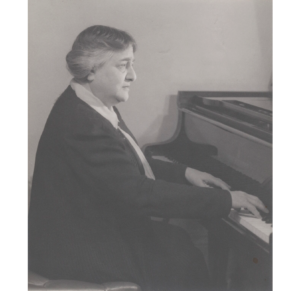 year: from the very beginning, she suffered headaches on the boat crossing that dampened her mood significantly and rendered her incapable of working. Bruce Hungerford stated that she complained of stiffness and numbness in her left arm and hand while practicing prior to her New York recital. Headaches continued and her technical certainty waned, the recital suffering from some issues with coordination. She then had a cerebral thrombosis while at her hotel but the gravity of her condition was kept under wraps, being described publicly as an attack of the flu. Brain surgery was suggested but rejected, and Hess was confined to dark quarters from February through March, finally being well enough to sail home in April.
year: from the very beginning, she suffered headaches on the boat crossing that dampened her mood significantly and rendered her incapable of working. Bruce Hungerford stated that she complained of stiffness and numbness in her left arm and hand while practicing prior to her New York recital. Headaches continued and her technical certainty waned, the recital suffering from some issues with coordination. She then had a cerebral thrombosis while at her hotel but the gravity of her condition was kept under wraps, being described publicly as an attack of the flu. Brain surgery was suggested but rejected, and Hess was confined to dark quarters from February through March, finally being well enough to sail home in April.
Her final public appearance was an October 1961 performance at the Royal Festival Hall of Mozart’s A Major Concerto K.488 with Sir Adrian Boult conducting. For years, Hess had resisted the idea that Mozart had expected the soloist to fill in the blanks left by large intervals; after discussions with Howard Ferguson in the 1940s, she did so in many cases, but not in the slow movement of this concerto. (Ferguson had said, “If you are doubtful about the additions don’t do them, for in that case they’ll never sound convincing.”) On this occasion, however, she used additions provided by Denis Matthews in the Adagio, and the effect is absolutely revelatory – all the more poignant given that this was to be her last concert.
In this interview with John Amis recorded two years before she died (graciously shared on the Past Daily website), we can hear that she still retained her wit despite not being quite as animated as she was not long before. She shares some wonderful details about her life and views of music:
Her final years were challenging, as she lacked the energy to teach at a time when playing was no longer possible; she told visiting doctors that she was so miserable that she wanted to die. She suffered from worsening rheumatism and friends believed that some brain damage from the stroke might have caused changes in character. Her condition progressively worsened and she died at home on November 25, 1965 at the age of 75.
Recorded Legacy
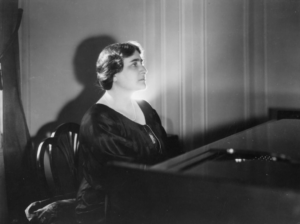
In addition to the tales of her heroic music-making, today’s piano fans know of Hess from her recordings – a significant legacy that is nevertheless but a shadow of her capabilities. With only 5 CDs’ worth of official solo and concerto recordings (there is more chamber music), the repertoire on these discs is a fraction of what she played for the public in her extensive career. She herself did not like the recording process – she dreaded the red light – and it is something for the present day listener to consider when one hears that Hess herself did not find her recordings representative of her playing, since they are considered today to be exceptional; those who heard her in concert say the same thing. Fortunately we have a significantly greater number of concert and broadcast recordings than studio accounts, which show her more in her element, although it has been said that the richness of her tone could not be faithfully captured by the microphone.
Her first recording took place in the United States: a December 1927 account of Schubert’s Trio in B-Flat D.898 with Jelly d’Arányi on violin and Felix Salmond as cellist. This spirited performance is presented here with her February 16-17, 1928 recording of Schubert’s Sonata in A Major D.664:
While Hess came to be known for the German repertoire, she had a much broader range of works in her repertoire, as evidenced by this glorious February 17, 1928 account of three works by Debussy Poissons d’or, La fille aux cheveux de lin, and Minstrels, played with gorgeous tonal colours, skillful pedalling, and refined dynamic control.
Hess recorded very little for piano and orchestra in her 30 years in the studio: two versions of the Schumann Concerto (1937 and 1952) and a 1941 Symphonic Variations of Franck, the latter seldom seldom reissued (a Mozart C Major Concerto K.467 from 1942 was unpublished until decades after her death). She not only played 21 Mozart Concertos (all at the National Gallery during the war), but all the Beethoven, both Brahms, and many others. Fortunately there are dozens of concert recordings of her in a wide array of these works, performances which can be at odds with the perception one might have of her based on her studio discs. There are two concert recordings of the Brahms D Minor Concerto that have been issued in recent years, which show the truly titanic nature of her playing – here is her 1955 New York performance with Dimitri Mitropoulos conducting:
Perhaps even more legendary than this reading is her stunning Brahms B-Flat Concerto Op.83 with Bruno Walter, from a February 11, 1951 concert, which captures her big-scale playing and full-bodied sonority to perfection.
Of course Hess was remarkably refined in her pianism as well. Unfortunately she recorded very little Chopin – only the ubiquitous Nocturne Op.15 No.2 (everyone of her generation seems to have recorded it) – but the Polish composer figured regularly in her concert repertoire. This 1948 concert recording of the Nocturne in C Minor Op.48 No.1 captures remarkably forged phrasing and sumptuous nuancing at an incredibly spacious tempo:
For all the dramatic power and refined sensitivity that Hess brought to her performances, she will forever be tied to the Bach Jesu, Joy of Man’s Desiring chorale that she famously arranged. She recorded it at her first solo session on January 17, 1928 and at her final session on October 12, 1957. The latter performance is presented here, together with the score of her glorious transcription, revealing her stunningly beautiful singing tone, fluid phrasing, and reverential music-making. If these three minutes were all we had of her, we would be well aware of her position in the pianistic pantheon. Fortunately, we have many hours of recordings to enjoy of this supreme artist – long may we continue to appreciate her glorious contributions to the art of music.
